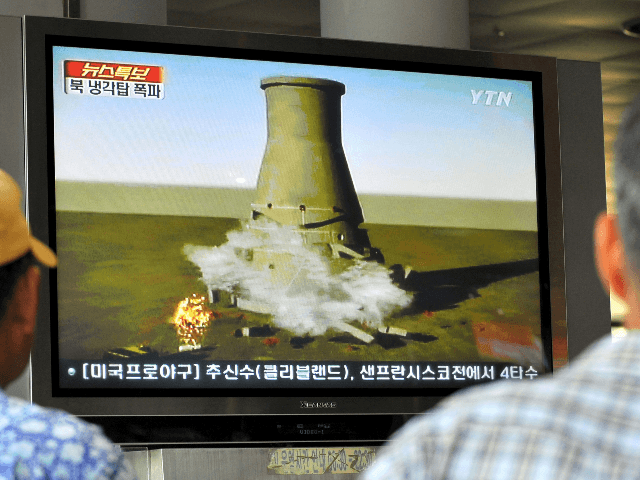The North Korea monitor site 38 North published satellite images on Wednesday showing activity at North Korea’s Yongbyon Nuclear Scientific Research Center. Experts believe the communist regime is enriching uranium at the site, which its diplomats claimed it was open to shutting down in exchange for sanctions relief.
The Yongbyon facility is not a nuclear weapons site. Instead, it is a place where North Korea has conducted many nuclear experiments and research and prepares materials for nuclear weapons, like enriched uranium.
The main known weapons facility in the country, the Punggye-ri Nuclear Test Site, is believed to have been largely destroyed by the nation’s last nuclear bomb test. The communist regime later claimed to have “demolished” it in a highly-publicized explosion. Since then, some reports have suggested parts of the deep tunnel system at the site may still be functional.
38 North stated in its report Wednesday that the main activity, observable in satellite images taken in the first half of this year, visible at the site is occurring at the Uranium Enrichment Plant (UEP). Uranium is most commonly found in its stable form, which is not usable as fissile material, so scientists have to enrich it (pull out the radioactive isotopes) to make it viable for nuclear energy.
“We continue to see activity around the Uranium Enrichment Complex in terms of vehicles, equipment and personnel arriving and departing,” the site reported. “Imagery shows what appears to be a white tanker trailer near the far west end of the complex on February 16 or 17 until the morning of March 27.”
The trailer, they suggest, may be full of liquid nitrogen, which is “necessary for operating cold traps in the uranium enrichment process. If this vehicle is a liquid nitrogen tanker trailer truck, then it is likely that it was periodically parked at this location to refill on-site storage tanks.”
The fact that they needed to refill the tanks, if indeed that is what the images show, would suggest that the North Koreans are enriching uranium. The activity is “a new indicator that the complex is operational, and therefore that it is also most likely producing enriched uranium.”
The site finds “minimal significant activity” elsewhere in the facility.
The revelation follows several rough months in the relationship between the United States and North Korea following the collapse of talks in February. President Donald Trump and dictator Kim Jong-un agreed to meet in Vietnam that month to discuss furthering denuclearization talks. After the end of the first of what was scheduled to be a two-day summit, Trump walked out, saying that the demands the Koreans had put forward were unreasonable for dropping sanctions. The president said that Kim’s team wanted an immediate end to the unprecedented sanctions placed on the country in exchange for future promises that they would end their nuclear program. Trump has made clear, however, that he does not support the end of sanctions until North Korea definitively proves that its nuclear program is completely, and irreversibly, dismantled.
“Basically, they wanted the sanctions lifted in their entirety and we couldn’t do that,” Trump said.
North Korean Foreign Minister Ri Yong-ho later disputed Trump’s claim, saying instead that North Korea agreed to dismantle the Yongbyon nuclear site in exchange for sanctions relief, which he called “realistic.”
Ri did not mention the offer of shutting down the nuclear program in its entirety.
Since the collapse of talks, North Korea has grown increasingly belligerent, particularly towards the United States.
“Nearly one year now since the declaration of the historic June 12 DPRK-U.S. Joint Statement, the U.S. should duly look back on the past one year and cogitate about which will be a correct strategic choice before it is too late,” the North Korean foreign ministry said in a statement on Wednesday. “The U.S. would be well-advised to change its current method of calculation and respond to our request as soon as possible. There is a limit to our patience.”
That same day, a foreign ministry official protested American officials’ use of the term “rogue state” to define North Korea, calling it “a clear infringement upon the latter’s sovereignty and dignity, and … nothing less than a de facto declaration of confrontation.”
“We are following with high vigilance the recent maneuvers of the U.S. to increase military pressure on us through several occasions,” the message warned. “The more the U.S. hostile acts towards the DPRK grow, the stronger our countermeasures will become.”
North Korea has also regressed into its intimidating military behavior. In May, Pyongyang launched at least one unspecified projectile in the direction of Japan. The country’s state newspaper Rodong Sinmun celebrated the launch as proof of North Korea’s status as an “invincible power that has fulfilled the historic cause of parallel development,” meaning both military and economic development.

COMMENTS
Please let us know if you're having issues with commenting.